The idea that a vast stream of water-laden comets crashing on our planet gave Earth its oceans is a long-held theory that has comfortably persisted for decades. Now however scientists have suggested that it took just one large Mars-sized object to flood our world with water; one that swept in from the outer Solar System and the same body that also happened to form the Moon.
Unlike the ice giants that linger far from the Sun, our planet, and the other rocky-bodies like it, are said to have formed in the inner solar system. From past studies, scientists have been able to ascertain that the Solar System became structured in such a way that 'dry' materials I.e those lacking a substantial amount of water were separated from those considered to be 'wet' materials.
This line of reasoning is evidenced by two types of meteorite; relatively dry ’non-carbonaceous' meteorites that come from the inner Solar System and the so-called 'carbonaceous' meteorites, which are more abundant in H2O and come from further afield in the outer Solar System.
Why then is our planet surprisingly water-rich compared with our small, rocky neighbours? Many planetary scientists are in agreement that an extensive bombardment of comets showered the inner Solar System earlier in its history to provide the water we see around us today. The same may have happened with the likes of Venus or Mars, but over eons, the water has disappeared for one reason or another.
Many are also of the opinion that our nearest celestial neighbour, the Moon, formed when a planet-sized body collided with a young Earth. The exact nature of the impact and its ensuing fallout have not been agreed upon entirely, but the object – called Theia – is generally accepted to have originated in the inner solar system near the Earth.
This hypothesis is now being turned on its head as researchers at the University of Münster (Germany) have been able to show, for the first time, that water came to Earth with the formation of the Moon some 4.4 billion years ago and that the visitor intent on transforming our world was in fact not local but from way out of town instead.
The essential ingredient in this new study, are isotopes of a silvery-white metal that is essential for life; molybdenum. An isotope is a variant of a particular chemical element which has the same number of protons, but a different number of neutrons in each atom. Molybdenum does not occur naturally as a free metal on Earth because it is prone to losing its electrons; instead it readily forms alloys with other elements and is used extensively in the production of steel.
Highly resistant to corrosion, this ductile metal is now helping scientists work out two key conundrums in planetary science - Earths water content and the formation the Moon.
“The molybdenum isotopes allow us to clearly distinguish carbonaceous and non-carbonaceous material, and as such represent a 'genetic fingerprint' of material from the outer and inner solar system," explains Dr. Gerrit Budde of the Institute of Planetology in Münster and lead author of the study.
What does this ‘genetic fingerprint’ tell Budde and colleagues about our planet’s prolific water content? Measurements of the molybdenum isotopic composition of Earth lies between those of the carbonaceous and non-carbonaceous meteorites, meaning that some of Earth's molybdenum originated in the outer solar system.
Because molybdenum loves to bond with other metals, especially iron, most of the molybdenum found on Earth is located in our molten core. "The molybdenum which is accessible today in the Earth's mantle, therefore, originates from the late stages of Earth's formation, while the molybdenum from earlier phases is entirely in the core," explains Dr. Christoph Burkhardt, second author of the study.
This, the researchers say, is proof that carbonaceous material from the outer solar system arrived on our planet late in the game. Consequently, since a large part of the molybdenum in Earth's mantle originates from the outer solar system, this means that Theia itself must also herald from the same region of space. What’s more, the carbonaceous material contained within this planet-size transformer of worlds, Theia, was enough to supply the entire amount of water on Earth, when it collided.
"Our approach is unique because, for the first time, it allows us to associate the origin of water on Earth with the formation of the Moon”, says Thorsten Kleine, Professor of Planetology at the University of Münster. “To put it simply, without the Moon there probably would be no life on Earth.”











